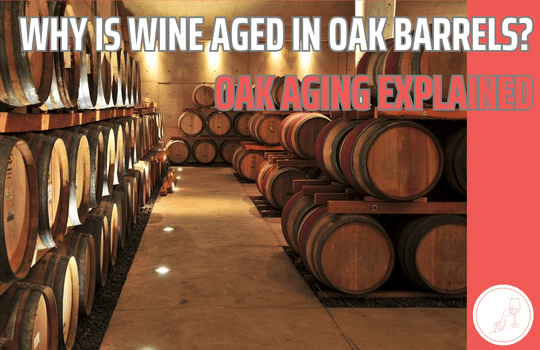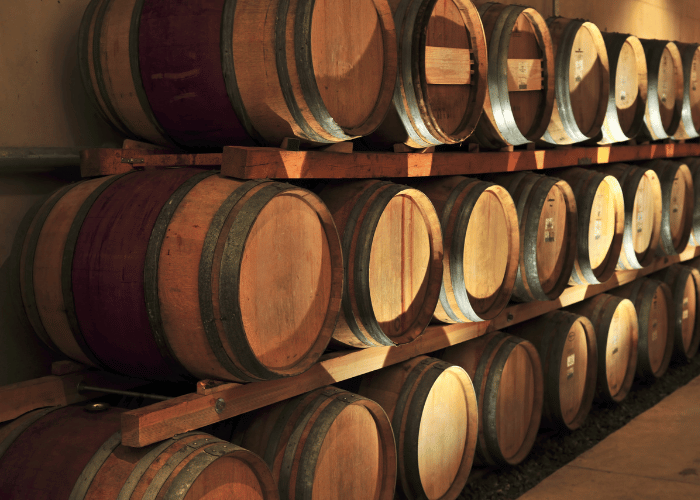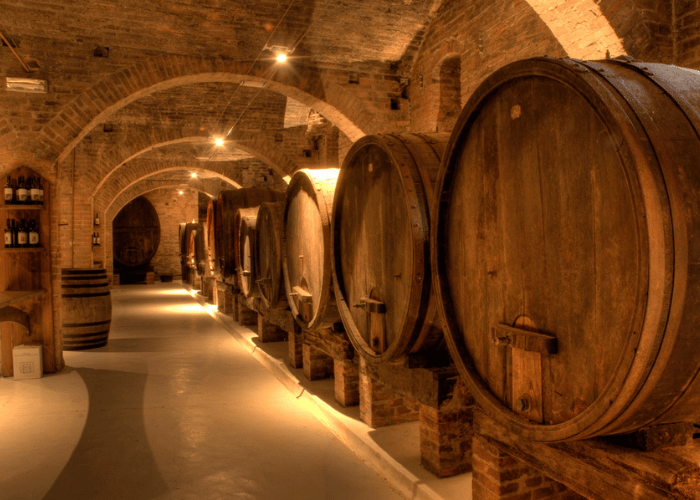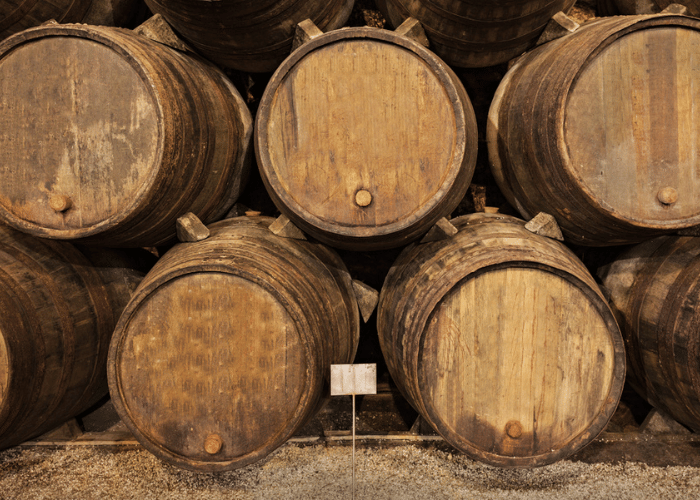Why is Wine Aged in Oak Barrels? [Wine Oak Aging Explained]

In this guide, I explain the transformative world of oak aging, where barrels are not just containers, but tools, subtly shaping the character of every wine.
Discover how this age-old art blends science and tradition, creating the wines we know and love.
Why is Wine Aged in Oak?
Oak aging is a crucial process in winemaking that can significantly influence the flavor, texture, and overall profile of a wine.
When wine is aged in oak barrels, it undergoes a series of subtle changes, acquiring characteristics from the wood.
Oak imparts aromas and flavors like vanilla, caramel, spice, and toast.
Additionally, the interaction between the wine and the oxygen that slowly permeates the wood helps to soften the wine's tannins, resulting in a smoother mouthfeel.
Oak aging can also contribute to the wine's structure and complexity. The slow oxidation process that occurs in barrels helps to stabilize the wine's color and integrate its flavors, often leading to increased depth and richness.
The Effects of Oak Aging on Wine

Oak Barrel Aging - A More Technical Answer
At its core, the interaction between wine and oak involves the transfer of compounds from the wood to the wine, most notably tannins, which are a class of phenolic compounds.
When wine is aged in oak barrels, it absorbs tannins and other phenolic compounds from the wood.
These phenolic compounds, including ellagitannins, are crucial in the development of the wine's structure, mouthfeel, and flavor/aroma profile.
Ellagitannins are hydrolyzable tannins found in oak wood, which differ from the condensed tannins naturally present in grape skins and seeds.
The process of tannin and flavor absorption is influenced by several factors:
But, barrel aging wine isn't just about imparting notes from the oak onto the wine.
Aging in a barrel allows the wine to undergo further chemical reactions. An example of this is malolactic fermentation (MLF).
Most red wines go through this process and also certain whites such as Chardonnay and Viognier.
MLF converts tart tasting malic acid into lactic acid (and carbonn dioxide). This results in a softer, richer texture.

The History of Oak Aging
The history of oak aging dates back centuries, with its origins believed to be in the Roman Empire.
Oak barrels were initially valued for their strength and reliability for storing and transporting liquids.
However, it was eventually noticed that wines stored in oak barrels took on desirable characteristics. Over time, winemakers began to understand and appreciate the positive effects of oak on wine, leading to the intentional use of oak barrels for aging.
This practice became more refined over the centuries, especially in regions like France, where the choice of oak and aging techniques became a critical part of the winemaking tradition.
Today, oak aging is a respected and essential part of winemaking worldwide, with each wine region having its own traditions and preferences regarding oak use.
Which Wines Benefit from Oak Aging?
Not all wines are suited for oak aging, and the decision to use oak depends on the type of wine and the desired end result.
Typically, full-bodied red wines like Cabernet Sauvignon, Merlot, and Shiraz benefit greatly from oak aging. The slow oxidation process helps to soften the wine's natural tannins and the oak notes lead to a more rounded, complex flavor profile.
Certain white wines, such as Chardonnay, also benefit from oak aging. Chardonnay undergoes malolactic fermentation while in the oak barrel. This process combined with the oak influence add richness and creamy textures, along with flavors like vanilla and butter.
However, lighter wines, such as Pinot Grigio or Sauvignon Blanc, are generally not oak-aged as the strong oak flavors can overwhelm their delicate fruity and floral characteristics.

How Long Does Wine Age in Oak For?
In the complex world of winemaking, the period a wine spends in oak barrels is a nuanced decision that significantly influences its character and complexity.
Each wine, with its unique personality and narrative, requires a tailor-made approach to oak aging.
Lighter white wines, like a crisp Sauvignon Blanc or a delicate Pinot Grigio, may undergo a brief sojourn in oak.
This period rarely exceeds six months, allowing these wines to acquire a whisper of oak's nuances without overshadowing their inherent vibrancy and fruitiness. The aim is to enrich the wine's profile subtly, adding layers of complexity while preserving its fresh, lively essence.
In contrast, fuller-bodied white wines, such as an opulent Chardonnay, frequently bask in the embrace of oak for a more extended period, ranging from six months to a year.
This lengthier tenure in oak imparts a richer palette of flavors, from the creamy vanilla notes to a hint of toasty warmth, transforming the wine into a symphony of complexity.
A classic example would be a Burgundian Chardonnay, which gains its renowned depth and buttery texture from this carefully calibrated oak aging.
Red wines, with their bold personalities, generally require a longer oak aging process. This can vary from a modest six months for a youthful, fruit-forward wine like a Beaujolais, up to two years or more for more structured, tannic varieties such as a robust Bordeaux blend or a tannin-rich Cabernet Sauvignon.
The extended aging in oak allows these reds to soften, mellow, and integrate their flavors, evolving into wines of profound depth and elegance. For instance, a premium Barolo might spend two years in oak, gaining its signature complexity and silkiness.
At the pinnacle of oak aging are the very high-quality and complex wines, which are cradled in oak for over two years.
Such prolonged aging is not a mere passage of time but a transformation where the wine and wood engage in a slow, harmonious dance.
This extended period allows for an intricate interplay of flavors, textures, and aromas, resulting in wines of extraordinary complexity and nuance.
A classic example would be a Grand Cru Burgundy, whose extended aging in carefully selected oak barrels endows it with a profound complexity and a seamless integration of flavors.
Wine | Typical Oak Aging Duration | Types of Oak Used |
|---|---|---|
Cabernet Sauvignon | 9 to 18 months | Mostly French oak, some American oak |
Chardonnay | 6 to 12 months | French oak (for subtler flavors), American oak (for bolder vanilla flavors) |
Pinot Noir | 10 to 18 months | Predominantly French oak |
Syrah/Shiraz | 12 to 18 months | Both American and French oak, depending on the style |
Merlot | 12 to 18 months | Mainly French oak, some American oak |
Zinfandel | 12 to 16 months | Primarily American oak |
Rioja | 12 to 24 months | American oak traditionally, increasingly French oak |
Barolo | 24 to 36 months | Slovenian and French oak |
Bordeaux Blends | 18 to 24 months | French oak, with some American oak in New World examples |
Malbec | 12 to 18 months | French and American oak |
Types of Oak Used for Aging
The type of oak and the way it is used play a significant role in the wine's final character. The most commonly used oak types are:
In addition to the origin of the oak, the treatment of the barrels (such as the intensity and duration of toasting) also affects the flavor imparted to the wine.
Winemakers carefully select their barrels based on these factors to achieve the desired outcome in their wines.
